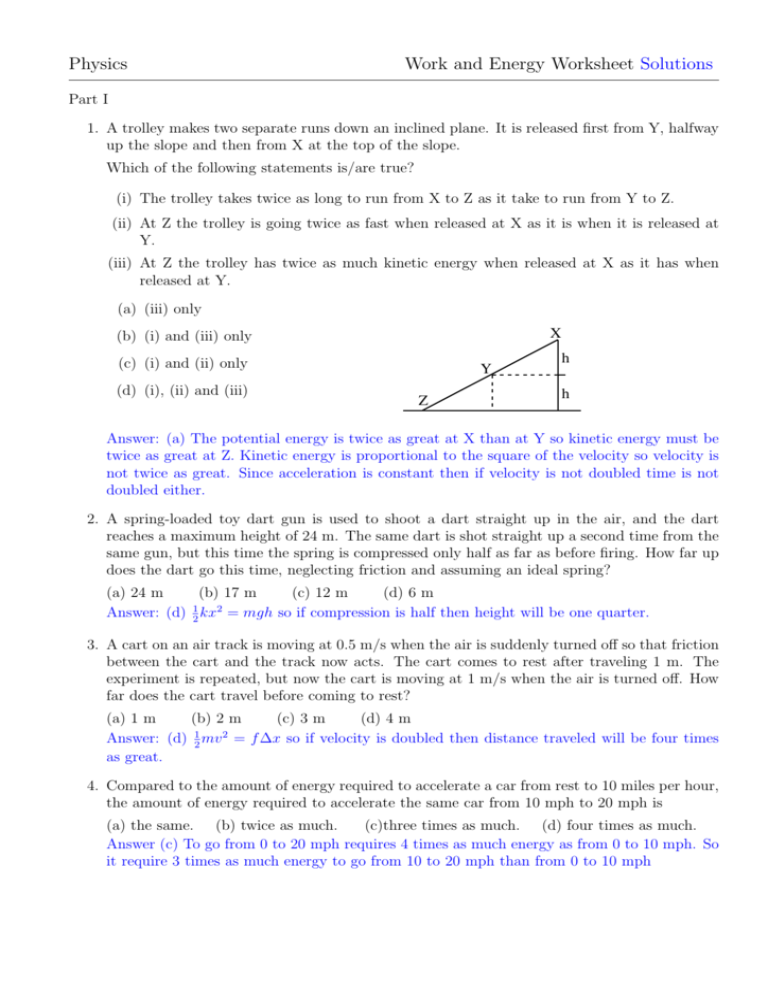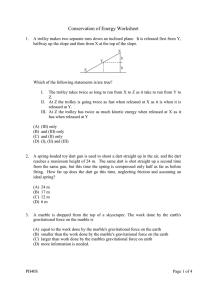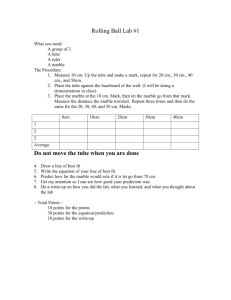Physics Work and Energy Worksheet Solutions
advertisement

Physics Work and Energy Worksheet Solutions Part I 1. A trolley makes two separate runs down an inclined plane. It is released first from Y, halfway up the slope and then from X at the top of the slope. Which of the following statements is/are true? (i) The trolley takes twice as long to run from X to Z as it take to run from Y to Z. (ii) At Z the trolley is going twice as fast when released at X as it is when it is released at Y. (iii) At Z the trolley has twice as much kinetic energy when released at X as it has when released at Y. (a) (iii) only X (b) (i) and (iii) only (c) (i) and (ii) only (d) (i), (ii) and (iii) Y Z h h Answer: (a) The potential energy is twice as great at X than at Y so kinetic energy must be twice as great at Z. Kinetic energy is proportional to the square of the velocity so velocity is not twice as great. Since acceleration is constant then if velocity is not doubled time is not doubled either. 2. A spring-loaded toy dart gun is used to shoot a dart straight up in the air, and the dart reaches a maximum height of 24 m. The same dart is shot straight up a second time from the same gun, but this time the spring is compressed only half as far as before firing. How far up does the dart go this time, neglecting friction and assuming an ideal spring? (a) 24 m (b) 17 m (c) 12 m (d) 6 m 1 2 Answer: (d) 2 kx = mgh so if compression is half then height will be one quarter. 3. A cart on an air track is moving at 0.5 m/s when the air is suddenly turned off so that friction between the cart and the track now acts. The cart comes to rest after traveling 1 m. The experiment is repeated, but now the cart is moving at 1 m/s when the air is turned off. How far does the cart travel before coming to rest? (a) 1 m (b) 2 m (c) 3 m (d) 4 m 1 2 Answer: (d) 2 mv = f ∆x so if velocity is doubled then distance traveled will be four times as great. 4. Compared to the amount of energy required to accelerate a car from rest to 10 miles per hour, the amount of energy required to accelerate the same car from 10 mph to 20 mph is (a) the same. (b) twice as much. (c)three times as much. (d) four times as much. Answer (c) To go from 0 to 20 mph requires 4 times as much energy as from 0 to 10 mph. So it require 3 times as much energy to go from 10 to 20 mph than from 0 to 10 mph 5. A marble is dropped from the top of a skyscraper. The work done by the earth’s gravitational force on the marble is (a) equal to the work done by the marble’s gravitational force on the earth (b) smaller than the work done by the marble’s gravitational force on the earth (c) larger than work done by the marbles gravitational force on earth (d) more information is needed. Answer (c) The force on the marble due to the earth equals the force on the earth due to the marble, but the displacement of the earth is negligible compared with the displacement of the marble so the work done by the marble on the earth is negligible. Part II 1. In the sport of Bungee Jumping people stand on a high platform and allow themselves to fall while tied to the platform by an elastic cord attached to their ankles. Johanna does a bungee jump. The unstretched length of the bungee cord is 20.0 m. Johanna’s centre of mass is 1.0 m above her feet when she is standing and her mass is 54.0 kg. In her initial drop the lowest point she reaches is when her feet are 45.0 m below the platform (Since she is upside down while she is falling her centre of mass is 47.0 m below its initial position). 20 m 45 m A B C (a) As Johanna drops, describe the energy changes taking place. Do this by writing increasing, decreasing or constant under the headings gravitational potential energy, kinetic energy and elastic potential energy in the table below. The top row refers to energy changes between her initial position on the platform and position A – the point where the bungee cord just starts to stretch; the middle row as she falls from point A to point B – the final equilibrium position; and the bottom row as she falls from point B to position C the lowest point of her initial drop. From platform to A From A to B From B to C gravitational potential energy decreasing decreasing decreasing kinetic energy increasing increasing decreasing elastic potential energy constant increasing increasing (b) Using conservation of energy find Johanna’s speed at point A just before the bungee starts to stretch. Conservation of Energy: Ef = Ei ⇒ 12 mv 2 + mghf = mghi √ √ ⇒ 12 v 2 = ghi − ghf ⇒ v 2 = 2g(hi − hf ) ⇒ v = 2g∆h = 2 × 9.8 × 22 = 21 m/s. Note: ∆h is 22 m and not 20 m since her centre of mass is now below her feet rather than above her feet. (c) Again by using conservation of energy find how much energy is stored in the bungee cord at point C when Johanna is momentarily at rest at her lowest position? Conservation of Energy: Espring = Ef = Ei = mghi = 54 × 9.8 × 47 = 25 KJ (d) From your answer to (c) find the magnitude of the spring constant of the bungee assuming it obeys Hooke’s Law. Espring = 12 kx2 ⇒ k = 2Espring /x2 and x = 45 − 20 = 25 m so k = 2 × 25000/252 = 80 N/m (e) Calculate the net force acting on Johanna at C and hence find her acceleration as she bounces back up again. By Hooke’s Law Fs = kx and Fnet = Fs − mg = kx − mg = 80 × 25 − 54 × 9.8 = 1470 N so a = Fnet /m = 1470/54 = 27 m/s2 up. (f) After bouncing up and down a number of times she loses energy and comes to rest at B hanging by her angles. By how much is the cord stretched at B. At equilibrium Fs = mg ⇒ kx = mg ⇒ x = mg/k = 54 × 9.8/80 = 6.6 m (g) What problems could arise if the spring constant of the bungee were too small? too large? If the spring constant is too large the acceleration at the lowest point will be too large and the jumper could be hurt. If the spring constant is too small the jumper will descend too far and will crash into the river.






